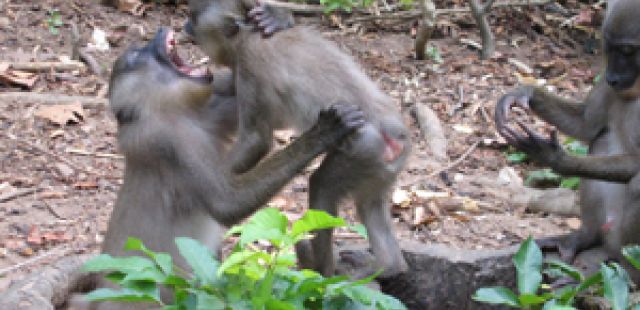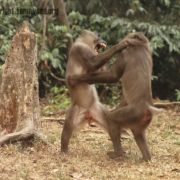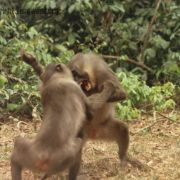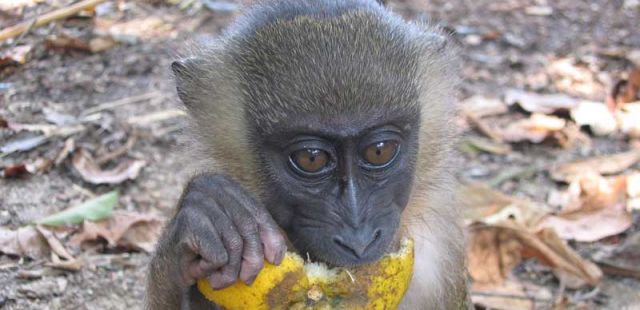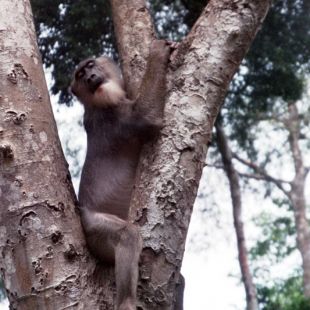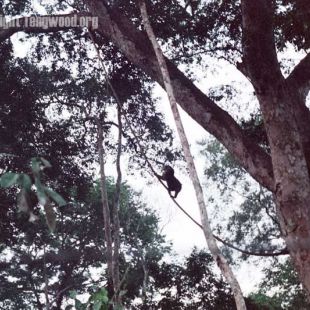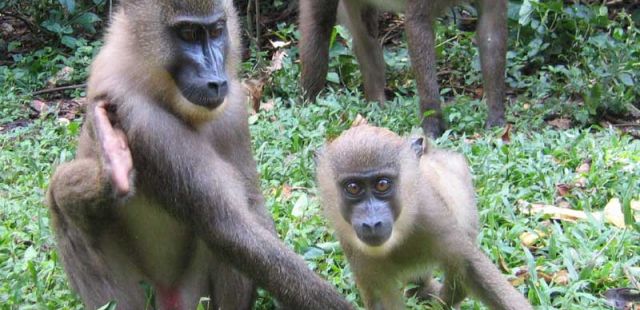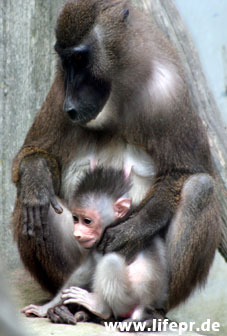 Drills are not common in zoos, so most people have never seen a drill, or even a picture of one! The average person will not know what a drill monkey is if asked. In contrast, most people will recognize a mandrill. Why are there so few drills in zoos? It is possible that because drills and mandrills are so similar, that zoos historically chose to exhibit mandrills because of their more colorful faces. It is also possible that early collecting expeditions occurred more often in forests below the Sanaga, where mandrills rather than drills occur. The drill's range and population size may also have always been smaller, meaning less ended up in captivity. Drills don't reproduce well in zoos either. In North America, there are only about 16 drills, found in 4 zoos. In Europe, there are approximately 60 drills, in some 12 zoos. German zoos have had the most success in breeding drills, but the zoo drill population is just as endangered as their counterparts in the wild! If you live near a zoo that has drills, visit and tell them you think it is important for zoos to support field efforts (such as Tengwood.org) to save drills!
Drills are not common in zoos, so most people have never seen a drill, or even a picture of one! The average person will not know what a drill monkey is if asked. In contrast, most people will recognize a mandrill. Why are there so few drills in zoos? It is possible that because drills and mandrills are so similar, that zoos historically chose to exhibit mandrills because of their more colorful faces. It is also possible that early collecting expeditions occurred more often in forests below the Sanaga, where mandrills rather than drills occur. The drill's range and population size may also have always been smaller, meaning less ended up in captivity. Drills don't reproduce well in zoos either. In North America, there are only about 16 drills, found in 4 zoos. In Europe, there are approximately 60 drills, in some 12 zoos. German zoos have had the most success in breeding drills, but the zoo drill population is just as endangered as their counterparts in the wild! If you live near a zoo that has drills, visit and tell them you think it is important for zoos to support field efforts (such as Tengwood.org) to save drills!
Mothers and daughters may remain together for a lifetime, or individuals may leave and join another group - no one really knows. It seems that age mates (other drills born at the same time/season - known as a 'cohort') may be very important. Drills give birth seasonally, which means that most babies are born in the same season - specifically, in the rainy season, when food is abundant. Infant drills are weaned from their mothers at the tender age of 3-6 months; during this weaning period, young drills begin to leave their mother and join large play groups, made up of all the juveniles in the group. Drill play groups are boisterous and fun to watch! But there is a serious undercurrent to them - play is meant to teach young animals the skills necessary to survive in the adult world. Hence, play fighting prepares a male for later in life, when the fighting is real. For drills, play also allows them to establish relationships with their peers that have a lasting effect.
Juvenile drills spend a lot of time playing. As they grow bigger, they begin to join in the more serious business of adult interactions. For females, this happens at 2-3 years of age (when they experience their first estrus cycle). Females have their first baby at around 3 years of age. For a male, maturity takes much longer - they are usually 7 to 10 years of age before they become adult (an adult male drill is more than twice the size of a female!). In the meantime, they continue to play and sometimes entertain themselves by causing mischief with the adults in the group.
Both drills and mandrills are wary of human observers and have remained elusive to study. Very little is really known about their lives in the forest, so bits and pieces have been put together by the various scientists studying these primates. Drills live in dense, primary forest and most of a drill group's day is likely spent traveling in search of food and they are known to have very large, seasonal home ranges (traveling up to 5 square kilometers a day). In the wild, most primates, including drills, spend the majority of their time just finding enough to eat. Overall, the forest is not an easy place to live - imagine searching the forest for food with a large, hungry group of people who are searching in the same place. It is a delicate balance between the safety of the social group and finding enough to eat.
The preferred food of the drill is forest fruits - when they can find them! The majority of the diet will be fruit when it is in season, but the distribution of fruiting trees is patchy and drills must know where to go and when fruits are in season. During the dry season, or times when fruit is scarce, drills must supplement their diet with other foods, such as young leaves and grasses, and the pith of tree branches. Most of a drill's time is spent foraging in the leaf litter. Here, drills find insects, which provide protein, and also seeds, which their hard molar teeth are thought to be specially designed to crack open. In fact, drills, mandrills, and mangabeys are believed to be 'seed specialists' (see Fleagle and McGraw's work on the specialized dental morphology of Mandrillus). Seeds last for long periods of time on the forest floor and are also high in protein. Primates that eat fruits and seeds, such as the drill and chimpanzee, play an important role in maintaining the forest via seed dispersal.
During travel, drills spend a large proportion of their time on the ground, resulting in reports that drills are 'terrestrial'. In truth, drills are very good climbers. Drills and mandrills have specialized forearm muscles and can cling vertically and leap long distances from tree to tree (see this video of mandrill locomotion in trees). They also spend their nights very high in the trees - a drill sleeps most comfortably about 100 feet up and balancing on a precarious branch! Drills sleep this way to avoid predators. In the morning, the group climbs down and travels on their daily food foray. The day also includes some rest stops, where the majority of socializing occurs. Captive drill groups living in natural forest enclosures in Nigeria were observed to socialize mostly at the beginning (dawn) and end (dusk) of their day, usually around the sleeping tree.
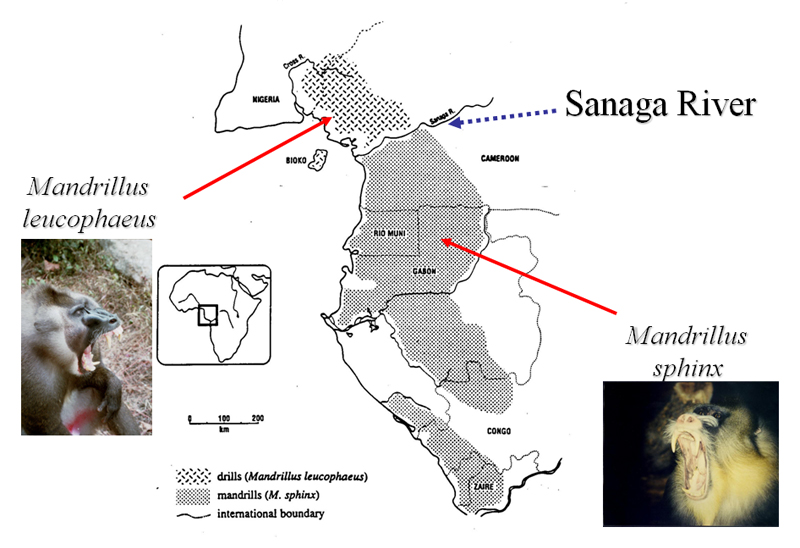
Drill monkeys are one of the most endangered primate species in the world. The drill is found in a very small geographic area with a high human density (from the Cross River in Nigeria to the Sanaga River in Cameroon - see Tengwood.org's 'Rivers and Wildlife' article). On this map, one can see that the drill has a much smaller range than the mandrill. Drills are classified by the IUCN as endangered. With their larger range and population size, in an area of Central Africa that is less populated by humans, mandrills are classified as threatened.
The drill monkey is one of the least well-known primates in Africa. Found only from the Cross River in Nigeria to the Sanaga River in Cameroon, they inhabit an area roughly the size of Switzerland, with possibly fewer than 3,000 left in the wild.
No one has been able to observe wild drills well in their dense forest habitat, so our knowledge of them is limited. Most of what is know comes from zoos and from a drill rehabilitation and breeding center in Nigeria known as Pandrillus. This sanctuary rescues drills from the illegal trade in bushmeat and wildlife and places them in large social groups in natural, forest enclosures in the Afi Mountains of Nigeria.




















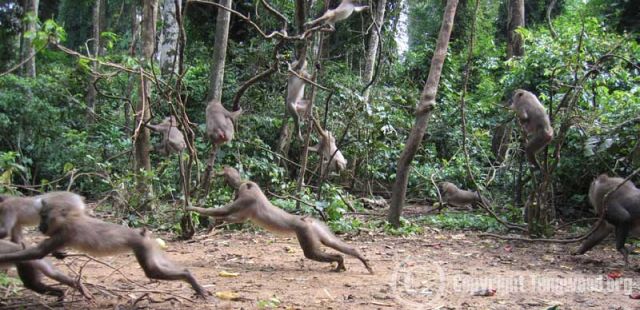
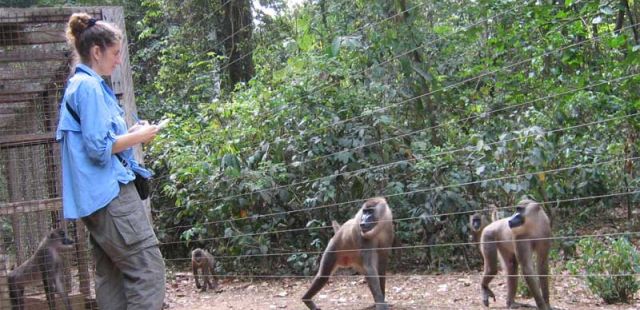
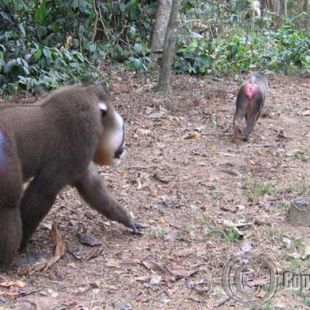
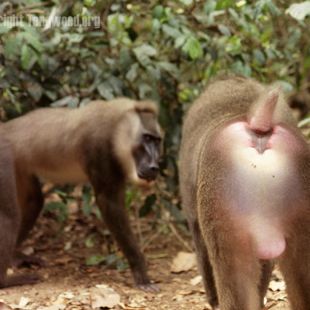
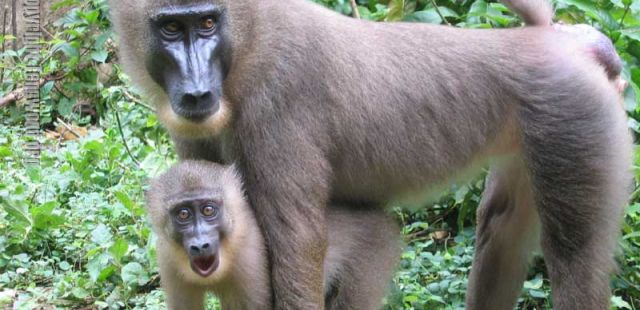
 In the past, drills and mandrills were called 'forest baboons' and classified with savanna baboons in the genus
In the past, drills and mandrills were called 'forest baboons' and classified with savanna baboons in the genus 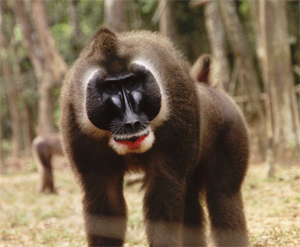 The drill is part of a unique genus, Mandrillus, which includes only one other primate, the most colorful mammal known to man - the mandrill.
The drill is part of a unique genus, Mandrillus, which includes only one other primate, the most colorful mammal known to man - the mandrill. 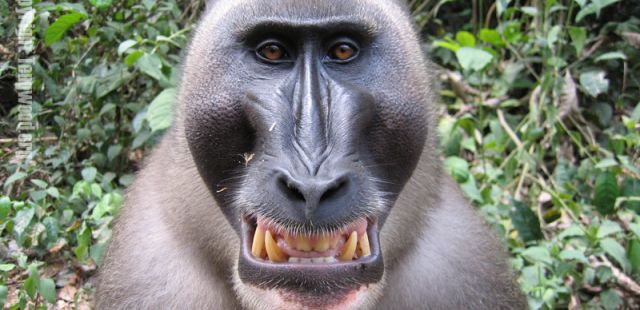
 Drills are not common in zoos, so most people have never seen a drill, or even a picture of one! The average person will not know what a drill monkey is if asked. In contrast, most people will recognize a mandrill. Why are there so few drills in zoos? It is possible that because drills and mandrills are so similar, that zoos historically chose to exhibit mandrills because of their more colorful faces. It is also possible that early collecting expeditions occurred more often in forests below the Sanaga, where mandrills rather than drills occur. The drill's range and population size may also have always been smaller, meaning less ended up in captivity. Drills don't reproduce well in zoos either. In North America, there are only about 16 drills, found in 4 zoos. In Europe, there are approximately 60 drills, in some 12 zoos. German zoos have had the most success in breeding drills, but the zoo drill population is just as endangered as their counterparts in the wild! If you live near a zoo that has drills, visit and tell them you think it is important for zoos to support field efforts (such as Tengwood.org) to save drills!
Drills are not common in zoos, so most people have never seen a drill, or even a picture of one! The average person will not know what a drill monkey is if asked. In contrast, most people will recognize a mandrill. Why are there so few drills in zoos? It is possible that because drills and mandrills are so similar, that zoos historically chose to exhibit mandrills because of their more colorful faces. It is also possible that early collecting expeditions occurred more often in forests below the Sanaga, where mandrills rather than drills occur. The drill's range and population size may also have always been smaller, meaning less ended up in captivity. Drills don't reproduce well in zoos either. In North America, there are only about 16 drills, found in 4 zoos. In Europe, there are approximately 60 drills, in some 12 zoos. German zoos have had the most success in breeding drills, but the zoo drill population is just as endangered as their counterparts in the wild! If you live near a zoo that has drills, visit and tell them you think it is important for zoos to support field efforts (such as Tengwood.org) to save drills!